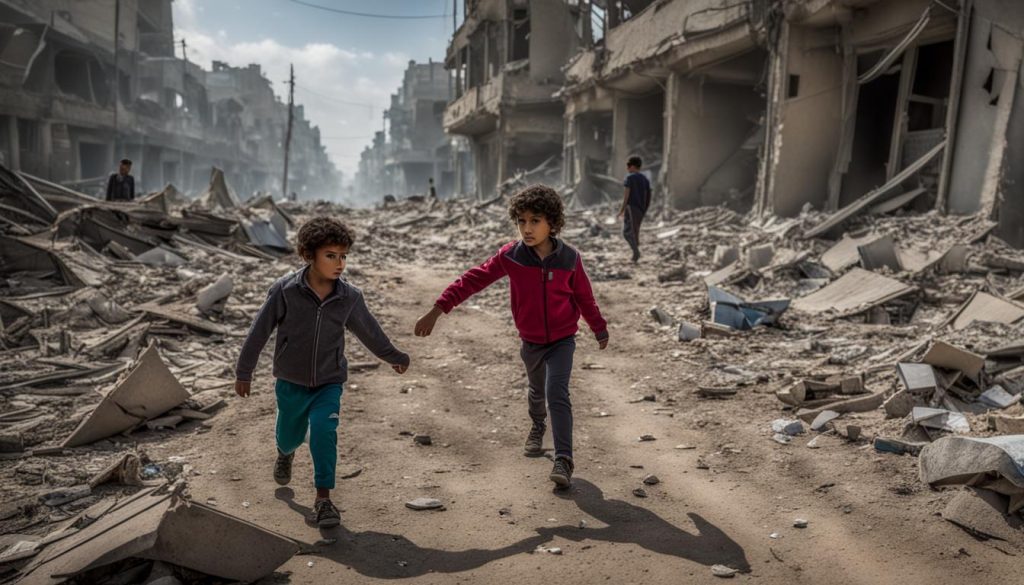The Gaza Strip conflict, also known as the Israeli-Palestinian conflict or the Gaza war, has recently escalated, leading to devastating consequences for both Israelis and Palestinians. The conflict has resulted in significant loss of life and injuries, causing concerns about the humanitarian crisis in Gaza, particularly among the young population.
In this article, we will explore how parents can approach conversations about the Gaza Strip conflict with their children. From discussing the historical context to addressing children’s safety concerns and promoting media literacy, we will provide practical guidance to help parents navigate the complex realities of this conflict and support their children through these challenging times.
Key Takeaways:
- Initiate conversations with children about the Gaza Strip conflict, using open-ended questions to encourage discussion.
- Provide age-appropriate explanations about the historical context of the conflict, including the formation of Israel and the ongoing blockade of Gaza.
- Address children’s safety concerns by using visual aids and assuring them of their personal security.
- Acknowledge the uncertainty of the situation and create a safe space for children to express their emotions and concerns.
- Teach children media literacy skills to evaluate news sources and critically analyze information.
Talking to Kids About the Gaza War: Starting the Conversation
In the wake of the recent conflict in the Gaza Strip, it is crucial for parents to initiate conversations with their children about the ongoing war. Regardless of personal connections to the region, discussing the conflict with children can help them better understand the situation and alleviate any fears or misconceptions they may have.
Experts recommend using open-ended questions to kickstart the conversation. By asking questions like, “What have you heard about the conflict?” or “How do you think the war is affecting people’s lives?”, parents can encourage children to express their thoughts and feelings. This creates an opportunity to address any misinformation and provide accurate information based on the child’s age and understanding.
“What have you heard about the conflict?”
Addressing Misconceptions and Fears
Children may have misconceptions or fears surrounding the Gaza war, and it is important for parents to address these concerns delicately. One effective approach is to offer age-appropriate explanations that provide historical context, such as the formation of Israel after World War II and the ongoing blockade of Gaza. This helps children develop a more nuanced understanding of the conflict and prevents them from making generalizations about entire populations based on the actions of a few individuals.
Older children should also be encouraged to critically evaluate news sources and videos shared on social media. Teaching them media literacy skills allows them to discern reliable information from biased or misleading content. By fostering critical thinking, parents can help their children navigate the vast amount of information available and develop a more well-rounded perspective on the conflict.
Connecting with children on an emotional level and providing reassurance is essential. Parents should create a safe space for children to voice their concerns, express their emotions, and ask questions. Encouraging them to get involved in positive actions, such as writing letters or participating in community projects, can empower children to make a difference and instill a sense of hope for a peaceful resolution.
img src=”https://seowriting.ai/32_6.png” alt=”Talking to kids about the conflict”
Explaining the Historical Context
Understanding the Israeli-Palestinian conflict requires examining its complex historical context. A key aspect is the formation of Israel after World War II, which created tension and displacement in the region. The United Nations Partition Plan for Palestine in 1947 aimed to establish separate Jewish and Arab states, but this plan was rejected by Arab leaders, leading to the 1948 Arab-Israeli War. As a result, the state of Israel was established, and many Palestinians became refugees.
Another significant factor is the ongoing blockade of Gaza, which has exacerbated the tensions between the two sides. In 2007, Hamas took control of Gaza, and since then, Israel and Egypt have imposed a blockade on the area, restricting the flow of goods, services, and people. This blockade has had severe humanitarian consequences, including limited access to basic necessities and high unemployment rates.
It’s important to approach the historical context with sensitivity and objectivity, avoiding oversimplification or generalizations. The conflict involves complex political, social, and religious dynamics, with multiple perspectives and narratives. By providing age-appropriate explanations, children can develop a more nuanced understanding of the conflict and foster empathy and open-mindedness.
The Formation of Israel
The formation of the state of Israel in 1948 was a significant turning point in the Israeli-Palestinian conflict. After the horrors of the Holocaust, Jewish survivors sought a homeland, and the international community supported the establishment of Israel. However, this led to the displacement of many Palestinians, creating a deep-rooted sense of injustice and fueling ongoing tensions.
The Blockade of Gaza
The blockade of Gaza, which began in 2007, has had profound consequences for the people living in the region. It has limited access to essential resources, including food, medicine, and clean water. The blockade has also restricted the movement of people, making it difficult for Gaza residents to travel, seek medical treatment, or pursue educational opportunities outside the region.
The Importance of Context
In explaining the historical context of the Israeli-Palestinian conflict, it is crucial to emphasize the complexity of the situation and recognize the diverse perspectives and narratives involved. By providing children with a balanced and comprehensive understanding, we can encourage critical thinking, empathy, and a desire for peaceful resolutions.
Addressing Children’s Safety Concerns
During times of conflict, children may have valid concerns about their safety. It is crucial for parents and caregivers to address these concerns in a sensitive and reassuring manner. By providing accurate information and creating a sense of security, parents can help ease children’s fears and promote their well-being.
Assuring Children of Their Safety
One effective way to address children’s safety concerns is by using visual aids such as maps. Show children the distance between their home and the conflict zone to emphasize that they are not in immediate danger. Explain that there are measures in place to protect them, such as security forces and emergency procedures.
Reassure children that their safety is a top priority and that adults are working to maintain peace and stability. Encourage them to express any fears or questions they may have and provide honest yet age-appropriate answers. Emphasize that they are not alone in their concerns and that their parents, caregivers, and community are there to support and protect them.
Creating a Sense of Security
In addition to verbal reassurances, parents can take practical steps to create a sense of security for children. This can include implementing safety measures at home, such as establishing a designated safe area and practicing emergency drills. Having a plan in place can help children feel more prepared and in control.
Furthermore, maintaining daily routines and engaging in activities that provide a sense of normalcy can also contribute to a child’s feeling of safety. Encourage children to pursue hobbies, spend time with loved ones, and engage in activities that bring them joy and comfort. This can help mitigate the impact of the conflict on their overall well-being.
By addressing children’s safety concerns proactively and providing them with reassurance and support, parents can help children navigate the challenges of conflict with resilience and a greater sense of security.

Dealing with Uncertainty and Absence of Answers
In times of conflict, it is natural for children to have questions and seek answers. However, it is important for parents to acknowledge that they may not have all the answers themselves. The focus should be on creating a safe and open space for discussion, where children can express their concerns and fears without judgment. Encourage them to voice their thoughts and emotions, as this will help them process their feelings and develop a better understanding of the situation.
Emphasize to your children that it is okay not to have all the answers at this moment. Explain that conflicts like the one in the Gaza Strip are complex and involve multiple factors that are difficult to comprehend fully. Assure them that they are not alone in their confusion and that even adults are still trying to understand the complexities of the situation.
Parenting is not about having all the answers; it’s about creating a safe space for exploration and growth.
Encourage your children to think critically and develop their own opinions. Help them understand that uncertainty is a part of life and that it is okay to question and reflect on the information they receive. Teach them the importance of seeking diverse perspectives and verifying facts before forming conclusions. By promoting critical thinking skills, you can empower your children to navigate uncertainty with confidence and resilience.
Coping Strategies for Dealing with Uncertainty
Here are some coping strategies you can use to help your children deal with uncertainty during times of conflict:
- Encourage open communication and active listening
- Provide reassurance and comfort
- Redirect focus to positive actions and initiatives
- Promote self-care and stress management techniques
- Engage in activities that foster hope and a sense of community
By implementing these strategies, you can create an environment that supports your children in navigating the uncertainties of the conflict while fostering their emotional well-being.
| Coping Strategies | Description |
|---|---|
| Encourage open communication and active listening | Provide a safe space for children to express their thoughts and concerns, and actively listen without judgment. Validate their emotions and offer support. |
| Provide reassurance and comfort | Offer words of reassurance and comfort that emphasize their safety and well-being. Remind them that you are there for them and will do everything you can to protect them. |
| Redirect focus to positive actions and initiatives | Encourage your children to get involved in positive actions such as fundraising for humanitarian aid or participating in local community projects. This empowers them to make a difference and gives them a sense of agency. |
| Promote self-care and stress management techniques | Teach your children self-care strategies such as deep breathing exercises, mindfulness, and engaging in activities they enjoy. These techniques can help them manage stress and anxiety during uncertain times. |
| Engage in activities that foster hope and a sense of community | Participate in activities that promote hope, compassion, and unity. This can include volunteering, writing letters of support to affected communities, or engaging in intercultural exchanges to foster understanding. |
Media Literacy and Critical Thinking
Teaching children media literacy skills is crucial in today’s digital age, where information is readily accessible in just a few clicks. By equipping children with the tools to evaluate news sources and think critically, parents can empower them to navigate the complexities of the Gaza Strip conflict with a discerning eye. Developing media literacy skills is not about instilling skepticism or dismissing all information; it’s about fostering an understanding of how media can shape narratives and biases.
“Media literacy helps children become active, engaged consumers of news, rather than passive recipients. It teaches them to question the credibility of sources, consider different perspectives, and identify any potential bias or agenda behind the information they encounter. By honing their critical thinking skills, children can distinguish between reliable sources and unreliable ones, enabling them to form well-informed opinions.”
Parents can start by discussing the importance of fact-checking and verifying information from multiple sources before accepting it as truth. Encourage children to explore diverse viewpoints and engage in discussions that challenge their own beliefs. This not only broadens their understanding of the conflict but also cultivates empathy and respect for differing perspectives.
Furthermore, parents should guide children in recognizing and questioning the presence of bias in news articles, headlines, and social media posts. Discuss how language choices, framing, and selective reporting can influence the way information is perceived. By teaching children to identify these elements, they can develop a more nuanced and critical understanding of the Gaza Strip conflict.
| Benefits of Media Literacy | Enhanced critical thinking skills | Ability to identify misinformation and bias |
|---|---|---|
| Expanded perspective and understanding of the conflict | Improved media literacy skills | Development of well-informed opinions |
| Empathy and respect for diverse viewpoints | Ability to navigate the digital landscape | Less susceptibility to propaganda |

By fostering media literacy and critical thinking skills in children, parents can equip them with the necessary tools to navigate the vast digital landscape and form well-informed opinions about the Gaza Strip conflict. Encourage children to be active participants in their media consumption, to question, analyze, and seek out reliable sources of information. In doing so, children can develop a more comprehensive understanding of the conflict and contribute to a future where informed dialogue and peace prevail.
Seeking Support and Providing Reassurance
During times of conflict, it is crucial for parents and caregivers to provide ongoing support and reassurance to children who may be distressed or anxious. Creating a safe and open environment for children to express their feelings and concerns is essential in helping them navigate the complexities of the situation.
Encouraging children to talk about their emotions and fears can help them process their feelings and find comfort in knowing that they are not alone. It is important for parents to actively listen to their children without judgment and to validate their emotions. Assuring children that their feelings are valid and that it is normal to feel scared or confused can go a long way in providing reassurance.
While it may be challenging to answer all of their questions, parents can still offer support by being honest and acknowledging when they don’t have all the answers. Reassuring children that there are people working towards finding peaceful solutions and emphasizing the importance of hope can provide a sense of comfort and stability.
| Ways to Support Children during Conflict | Ways to Provide Reassurance in Crisis |
|---|---|
|
|
“It’s important for children to know that they are not alone and that their feelings are valid. By creating a safe and open environment for them to express their emotions, we can provide the support and reassurance they need during times of crisis.” – Child psychologist, Dr. Sarah Thompson
Limiting Exposure to Graphic Content
During times of conflict, children are often exposed to distressing images and videos that can have a negative impact on their emotional well-being. It is crucial for parents and caregivers to take proactive steps in limiting children’s exposure to graphic content, ensuring their mental and psychological safety. By implementing strategies to protect children from graphic content, parents can help create a more nurturing environment for their emotional development.
Creating a Media-Free Zone
One effective way to limit exposure to graphic content is by creating a designated media-free zone in the home. This could be a specific room or area where children are encouraged to engage in other activities away from screens and media devices. By providing alternative forms of entertainment and fostering a media-free space, parents can help children disconnect from the constant bombardment of graphic images.
Monitoring and Filtering Media Consumption
Parents should be vigilant in monitoring and filtering the media content their children consume. This includes keeping an eye on the television shows, movies, and online videos that children watch, as well as the social media platforms they use. Implementing parental controls and setting age-appropriate restrictions can help prevent children from accidentally stumbling upon graphic content.
“Protecting children from graphic content is crucial for their emotional well-being during times of conflict. By creating a media-free zone and monitoring their media consumption, parents can safeguard their children from exposure to distressing images.”
Encouraging Open Communication
It is important for parents to maintain open lines of communication with their children regarding the conflict and the media content they may come across. By having conversations and answering their questions, parents can provide context and reassurance, while also addressing any concerns or fears that may arise. Encouraging children to share their feelings and emotions can help them navigate the impact of graphic images in a healthy and supported way.
In conclusion, limiting children’s exposure to graphic content during times of conflict is essential for their well-being. By creating a media-free zone, monitoring and filtering media consumption, and encouraging open communication, parents can protect their children from the negative effects of graphic content and help them navigate the complexities of the conflict with greater resilience.
| Benefits of Limiting Exposure to Graphic Content |
|---|
| Preserves children’s mental and emotional well-being |
| Creates a safe and nurturing environment for emotional development |
| Prevents the negative impact of distressing images on children |
| Allows children to focus on positive activities and experiences |
Conclusion
The Gaza Strip conflict is a multifaceted issue that demands careful understanding and compassionate engagement, particularly when discussing it with children. By initiating conversations, providing historical context, addressing safety concerns, promoting media literacy, and offering reassurance, parents can play a crucial role in helping children navigate the complexities of this ongoing conflict.
Starting conversations about the Gaza conflict allows children to express their thoughts, fears, and questions. By creating an open and safe space for dialogue, parents can foster empathy and critical thinking skills, enabling children to develop a broader understanding of the conflict.
Understanding the historical context is essential in providing children with a more nuanced perspective. By explaining the formation of Israel after World War II and the ongoing blockade of Gaza, parents can help children appreciate the complex factors contributing to the conflict.
Addressing safety concerns is crucial for alleviating children’s fears. Using visual aids and emphasizing the distance between their home and the conflict zone can help children feel secure. It is important to provide reassurance and emphasize the proactive steps taken to ensure their safety.
Media literacy plays a vital role in empowering children to navigate the overwhelming amount of information available. By teaching critical thinking skills, parents can guide children in evaluating news sources, recognizing bias, and assessing the credibility of online content.
In conclusion, by approaching discussions with children about the Gaza conflict thoughtfully and supportively, parents can help them develop a more comprehensive understanding of the complexities involved. By fostering compassion, understanding, and hope for a peaceful resolution, parents can nurture a generation that seeks to build a world free from violence and conflict.
FAQ
How should parents start the conversation about the Gaza conflict with their children?
Parents can start the conversation by using open-ended questions to initiate the discussion and addressing any misconceptions or fears children may have.
What historical context should be explained to children when discussing the Israeli-Palestinian conflict?
Children should be provided with age-appropriate explanations about the historical context, including the formation of Israel after World War II and the ongoing blockade of Gaza.
How can parents address children’s safety concerns during the conflict?
Parents can use visual aids, like maps, to demonstrate the distance between their home and the conflict zone, and assure children that they are safe by taking steps to create a sense of security.
What should parents do if they don’t have all the answers to their children’s questions about the conflict?
It’s important for parents to acknowledge that they may not have all the answers. The focus should be on creating a safe space for discussion and exploration, rather than providing definitive answers.
How can parents teach media literacy and critical thinking skills to children regarding the conflict?
Parents should guide children in evaluating news sources, recognizing biased information, and questioning the credibility of videos shared online to develop a more nuanced understanding of the conflict.
What support and reassurance should parents provide to children distressed by the conflict?
Parents should provide ongoing support and reassurance by creating a safe and open environment for children to express their feelings and concerns. Encouraging positive actions can also empower children to make a difference.
How can parents limit children’s exposure to graphic content related to the conflict?
Parents should limit children’s exposure to graphic images and repetitive media coverage of the conflict. Taking breaks from news consumption and engaging in alternative activities as a family can provide relief and help children process their emotions in a healthier way.
Source Links
- https://www.npr.org/2023/10/11/1205017249/how-to-talk-to-children-violence-israeli-palestinian-gaza-hamas
- https://www.nytimes.com/2023/10/13/learning/teaching-about-the-israel-hamas-war.html
- https://www.healthychildren.org/English/healthy-living/emotional-wellness/Pages/how-to-talk-with-your-child-about-the-israel-gaza-war.aspx
Assuring Children of Their Safety Coping Strategies for Dealing with Uncertainty How should parents start the conversation about the Gaza conflict with their children? Talking to Kids About the Gaza War Understanding the Gaza Strip Conflict: A Friendly Guide
Last modified: January 17, 2024





